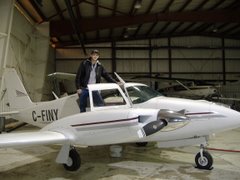This time the the reason I bounced all tied back to not having a stable approach. Normal approaches in the Navajo are done at 120 mph, and as we cross the airport fence we pull off the power slowly and let the airspeed bleed off so we're around 110 mph crossing the runway threshold. I'm finding that the Navajo is fairly sensitive to power changes, and it builds speed fairly quickly and doesn't lose it easily. Initially as I turned base I had the airspeed pegged at 120, but I found myself a little high, so I pushed the nose down and pulled off a touch of power, but apparently not enough, and soon enough I found the airspeed way up past 130 - way too fast. I spent the rest of the approach trying to work it back down, and ended up crossing the threshold carrying way too much speed. We floated for a long while in ground effect waiting for it to slow down, until the Captain eventually called me to chop the power cause we would be running out of runway soon. I pulled the power back to idle, and then that resulted in a bit of a firm landing with a small bounce.
That was a couple days ago, and today it was my turn again. This time I made sure I had the airplane properly slowed down and the approach speed and glideslope pegged with lots of time to spare. I made sure I stayed much more aware of my airspeed during power adjustments, and made a decent landing this time with no bounces. Still room for improvement, but we'll get there.
On a separate subject I saw a Twin Comanche doing touch and goes at our airport a few days ago. I couldn't help but stand and watch for a bit. It brought back memories, and made me wish for a few moments that I still had mine. It was just so much FUN.




Barb says: Shouldn't you be in left seat when you're flying?
ReplyDeleteNope, I have a full set of instruments and flight controls in the right seat, so I can fly the airplane from there just fine, and our SOPs state that I must occupy the right seat until I'm qualified as Captain.
ReplyDelete